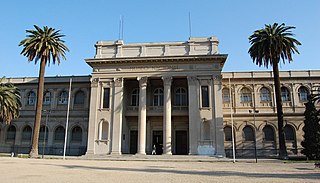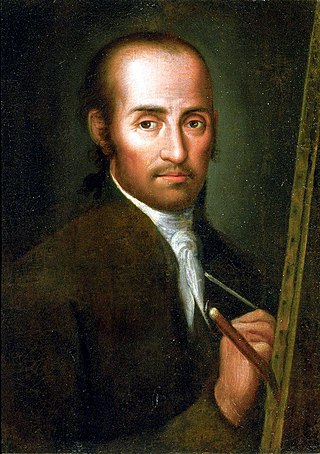
Antigua Guatemala, commonly known as Antigua or La Antigua, is a city in the central highlands of Guatemala. The city was the capital of the Captaincy General of Guatemala from 1543 through 1773, with much of its Baroque-influenced architecture and layout dating from that period. These characteristics had it designated as a UNESCO World Heritage Site in 1979. Antigua Guatemala serves as the capital of the homonymous municipality and the Sacatepéquez Department.

La Plata is the capital city of Buenos Aires province, Argentina. According to the 2022 census, the Partido has a population of 772,618 and its metropolitan area, the Greater La Plata, has 938,287 inhabitants. It is located 9 kilometers inland from the southern shore of the Río de la Plata estuary.

The National University of Colombia is a national public research university in Colombia, with general campuses in Bogotá, Medellín, Manizales and Palmira, and satellite campuses in Leticia, San Andrés, Arauca, Tumaco, and La Paz, Cesar. Established in 1867 by an act of the Congress of Colombia, it is one of the largest universities in the country, with more than 53,000 students. The university grants academic degrees and offers 450 academic programmes, including 95 undergraduate degrees, 83 academic specializations, 40 medical specialties, 167 master's degrees, and 65 doctorates. Approximately 44,000 students are enrolled for an undergraduate degree and 8,000 for a postgraduate degree. It is also one of the few universities that employs postdoctorate fellows in the country.

The National Museum of Anthropology is a national museum of Mexico. It is the largest and most visited museum in Mexico. Located in the area between Paseo de la Reforma and Mahatma Gandhi Street within Chapultepec Park in Mexico City, the museum contains significant archaeological and anthropological artifacts from Mexico's pre-Columbian heritage, such as the Stone of the Sun and the Aztec Xochipilli statue.

Machaquila is a major ruined city of the Maya civilization in what is now the El Peten department of Guatemala.

The National Museum of Natural Sciences is a natural history museum in Madrid, Spain. Dependent on the Ministry of Science, it is one of the National Museums of Spain, and it is managed by the Spanish National Research Council (CSIC).

The Chilean National Museum of Natural History is one of three national museums in Chile, along with the Museum of Fine Arts and the National History Museum. It is located in Quinta Normal Park, and was founded in 1830 by the French naturalist Claudio Gay.

José de Ibarra (1688–1756) was a New Spanish painter. He was born in Guadalajara, Mexico in 1688, and died November 21, 1756, in Mexico City, in the Viceroyalty of New Spain. Ibarra was a disciple of the distinguished painter Juan Correa (1646-1716), whose parents were of Afro-Moorish Afro-Mexican descent. José de Ibarra is, along with Juan Rodríguez Juárez (1675-1728), one of the most prominent figures in painting from the first half of the 18th century in New Spain, modern day's Mexico. A follower of the artistic renewal promoted by the brothers Juan and Nicolás Rodríguez Juárez, in whose workshop he collaborated, Ibarra cultivated in his work the language of pictorial modernism with strong Italian and French influences. This would be the direct antecedent of the work of Miguel Cabrera (1715-1768), whose fame would eclipse that of which Ibarra himself enjoyed among his contemporaries as a brush artist.

The Plomo Mummy is the well preserved remains of an Incan child found on Cerro El Plomo near Santiago, Chile in 1954. It was discovered by Guillermo Chacón Carrasco, Jaime Ríos Abarca, and Luis Gerardo Ríos Barrueto. The mummy was brought to the attention of Grete Mostny at the Chilean National Museum of Natural History; she later proved instrumental in the museum's acquisition of the specimen. The Plomo Mummy was the first notable frozen mummy discovery of high-altitude Capacocha human sacrifice by the Incas, a practice called qhapaq hucha.
The Museo Nacional de Arte Moderno "Carlos Mérida" is a national museum of modern art in Guatemala City, named after Carlos Mérida.
The Guatemalan National History Museum or Museo Nacional de Historia is a national museum in Guatemala City, Guatemala. The museum was founded in 1978.

Instituto Nacional Mejía is a public secondary educational institution of Quito. It was founded on June 1, 1897 by Eloy Alfaro Delgado, then president of Ecuador.
Juan Pedro Laporte Molina was a prominent Guatemalan archaeologist best known for his work on the ancient Maya civilization. He studied in the United States at the University of Arizona, in which he enrolled at the age of nineteen. After just one year he transferred to the Escuela Nacional de Antropología e Historia in Mexico. He continued his studies at the Universidad Autónoma de México from 1972 to 1976, from which he graduated with a doctorate in archaeology. He worked as a research assistant at the Museo Nacional de Antropología in Mexico City from 1967 through to 1976. Laporte worked at various archaeological sites while he was in Mexico, including Tlatilco, Chichen Itza and Dainzú. He first began working as an archaeologist in Guatemala in the 1970s, and was the head of the School of History of the Universidad de San Carlos de Guatemala (USAC) for more than thirty years. He first entered USAC in 1977, soon after returning from Mexico. In 1974 he carried out investigations at the Maya archaeological site of Uaxactun in the northern Petén Department of Guatemala. Between 1974 and 1976 he carried out archaeological investigations in Antigua Guatemala, which has since been designated as a UNESCO World Heritage Site, and around Lake Izabal.
The Museo Nacional de Historia Natural Cubana or Museo Nacional de Historia Natural de Cuba in Havana, Cuba is the national museum of Natural History, with exhibits of Cuba's plants and animals. It is located in a former U.S. embassy building.

Rebeca Acevedo was a Chilean professor and botanist. She was the first woman to head the botanical department of the Chilean National Museum of Natural History in 1947.

The National Museum of Natural History in Montevideo is a natural history museum in Uruguay. It opened in 1838, and is the oldest scientific institution in Uruguay and one of the oldest natural history collections in the world. The museum's first permanent exhibition space is at Miguelete 1825—the former Miguelete Prison—and the scientific collections, library and administrative offices are at Calle 25 de Mayo 582 in the Old City.
The Estanzuela Museum of Paleontology and Archaeology is a museum located in Estanzuela, Guatemala. The museum is dedicated to the preservation of archeological remains of Eastern Guatemala.

The Museum of the Ancient Book is a museum in Antigua Guatemala, Sacatepéquez. The museum is dedicated to show the different types of printing used in Guatemala.













